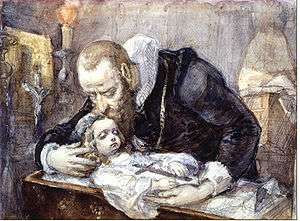Laments (Kochanowski)
The Laments (also Lamentations or Threnodies; Polish: Treny) are a series of nineteen threnodies (elegies) by Jan Kochanowski. Written in Polish and published in 1580, they are a highlight of Polish Renaissance literature, and one of Kochanowski's signature achievements.[1][2][3]
Composition
Jan Kochanowski was a prominent Polish poet. Kochanowski wrote the Laments on the occasion of the 1579 death of his daughter Urszula (in English, "Ursula").[1][2]

Little is known of Urszula (or Urszulka—"little Ursula"), except that at her death she was two and a half years old. Her tender age has caused some critics to question Kochanowski's truthfulness, when he describes her as a budding poetess — a "Slavic Sappho." There is, however, no doubt as to the unaffected sentiments expressed in the nineteen Roman-numbered Laments, of varying length, which still speak to readers across the four and a quarter centuries since they were composed.
The poems express Kochanowski's boundless grief; and, standing in sharp contrast to his previous works, which had advocated such values as stoicism, can be seen as the poet's own critique of his earlier work. In a wider sense, they show a thinking man of the Renaissance at a moment of crisis when he is forced, through suffering and the stark confrontation of his ideals with reality, to re-evaluate his former humanistic philosophy of life.[2]
The Laments belong to a Renaissance poetic genre of grief (threnody, or elegy), and the entire work comprises parts characteristic of epicedia: the first poems introduce the tragedy and feature a eulogy of the decedent; then come verses of lamentation, demonstrating the magnitude of the poet's loss and grief; followed at last by verses of consolation and instruction.[2]
Kochanowski, while drawing on the achievements of classical poets such as Homer, Cicero, Plutarch, Seneca and Statius, as well as on later works by Petrarch and his own Renaissance contemporaries such as Pierre de Ronsard, stepped outside the borders of known genres, and his Laments constitute a mixed form ranging from epigram to elegy to epitaph, not to mention psalmodic song.[2][3]
When the Treny were published (1580), Kochanowski was criticized for having taken as the subject of his Laments the death of a young child, against the prevailing literary convention that this form should be reserved for "great men" and "great events."[2][3]
Influence
The Laments are numbered among the greatest attainments of Polish poetry.[1][2] Their exquisite conceits and artistry made them a model to literati of the 16th and especially the 17th century.[2] The Laments have also inspired musicians , and painters such as Jan Matejko.
Translation into English
- 1920 by Dorothea Prall
- 1995 by Stanisław Barańczak and Nobel-laureate poet Seamus Heaney
Lament 1
All Heraclitus' tears, all threnodies
And plaintive dirges of Simonides,
All keens and slow airs in the world, all griefs,
Wrung hands, wet eyes, laments and epitaphs,
All, all assemble, come from every quarter,
Help me to mourn my small girl, my dear daughter,
Whom cruel Death tore up with such wild force
Out of my life, it left me no recourse.
So the snake, when he finds a hidden nest
Of fledgling nightingales, rears and strikes fast
Repeatedly, while the poor mother bird
Tries to distract him with a fierce, absurd
Fluttering — but in vain! the venomous tongue
Darts, and she must retreat on ruffled wing.
"You weep in vain," my friends will say. But then,
What is not in vain, by God, in lives of men?
All is in vain! We play at blindman's buff
Until hard edges break into our path.
Man's life is error. Where, then, is relief?
In shedding tears or wrestling down my grief?[4]
Notes
- Poet's Corner: "Jan Kochanowski's Threnodies Archived 2006-08-30 at the Wayback Machine", in Warsaw Voice, no. 43 (470) (October 26, 1997). Includes Threnody V.
- "Jan KOCHANOWSKI", by Prof. Edmund Kotarski, in the Virtual Library of Polish Literature.
- "The Threnodies of Jan Kochanowski". Excerpts from the book, Jan Kochanowski, The Threnodies, and The Dismissal of the Greek Envoys, by Barry Keane. Includes Threnodies I, III, VI, XII and XIX.
- From the Stanisław Barańczak-Seamus Heaney translation, p. 3.
References
- Barry Keane, Jan Kochanowski, Threnodies and The Dismissal of the Greek Envoys.
- Jan Kochanowski, Laments, translated by Stanisław Barańczak and Seamus Heaney, New York, Farrar, Straus and Giroux, 1995.
- Jan Kochanowski, Laments, translated by Michael J. Mikos, Warsaw, Constanz, 1995.
- Jan Kochanowski, Treny: the Laments of Kochanowski, translated by Adam Czerniawski, Oxford, Legenda, 2001.
- Michael J. Mikos, Polish Renaissance Literature: an Anthology, Slavica Publishers, 1995.
External links
| Wikisource has original text related to this article: |
- "Kochanowski's Humanists Laments" (PDF)., review of Laments translation by Barańczak and Heaney, by Felicity Rosslyn, Cambridge Quarterly, volume 26, issue 4.
- Bringing a Great Poet Back to Life, review of Laments translation by Barańczak and Heaney. by Czesław Miłosz, New York Review of Books, vol. 43, no. 3 (February 15, 1996). See also this reply.
- Leonard Kress on translating Treny, plus Treny 5,6 and 14
- Treny. Short descriptions and translation of 1 and 8 by Adam Czerniawski
- Treny. The Laments of Kochanowski Review of Czerniawski's translation, by Steven Clancy, Sarmatian Review, vol. XXIII, no. 1 January 2003.
- (in Polish) Treny – all the poems of the Treny series.
- Tren IX and possible image of Urszula
- (in Polish) Possible image of Urszula
- Laments, translated by Dorothea Prall